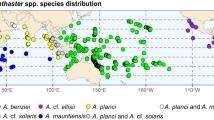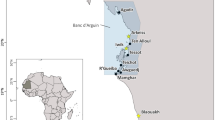Abstract
Capelin (Mallotus villosus) is among the most abundant fish species in the Barents Sea, and represents a critical food source for many predators in the area including Atlantic cod and harp seal. In Norway, the fish is of economic importance since whole capelin and roe are valuable export products. Despite its economic and ecological importance, the parasites of Barents Sea capelin are poorly known. However, the presence of parasites in the edible parts may adversely affect product quality and consumer safety. During the main annual catching seasons of 2009–2012, we investigated the diversity and infection dynamics of ascaridoid nematodes in capelin (n = 620) from the southern Barents Sea. Three anisakid species were identified by genetic or molecular methods; Anisakis simplex (s.s.), Contracaecum osculatum sp. B, and Hysterothylacium aduncum, with C. osculatum sp. B as the most prevalent and abundant species. The present findings suggest that the ascaridoid species composition in capelin reflects its trophic position in the Barents Sea ecosystem. There appears to be a link between infection level of the nematode species and the preferred prey organisms of the different developmental phases of capelin. Thus, the higher abundance of C. osculatum sp. B compared to A. simplex (s.s.) and H. aduncum may be related to more extensive feeding on calanoid copepods over a wider ontogenetic size range including adolescence, while the main intermediate hosts of the latter nematode species, i.e. euphausiids and amphipods, appear to be the preferred prey of larger capelin.




Similar content being viewed by others
References
Arthur JR, Albert E (1996) Parasites as potential biological tags for capelin (Mallotus villosus) in the St. Lawrence estuary and gulf. Can Tech Rep Fish Aquat Sci 2112:9
Arthur JR, Albert E, Boily F (1995) Parasites of capelin (Mallotus villosus) in the St. Lawrence estuary and gulf. Can J Fish Aquat Sci 52:246–253
Berland B (1961) Nematodes from some Norwegian marine fishes. Sarsia 2:1–50
Berland B (2003) Anisakis spp. In: Akuffo H, Linder E, Ljungstrøm I, Wahlgreen M (eds) Parasites of the colder climates. Taylor & Francis, England, pp 161–168
Bogetveit FR, Slotte A, Johannessen A (2008) The ability of gadoids to take advantage of a short-term high availability of forage fish: the example of spawning aggregations in Barents Sea capelin. J Fish Biol 72:1427–1449. doi:10.1111/j.1095-8649.2008.01808.x
Brattey J (1995) Identification of larval Contracaecum osculatum s.l. And Phocascaris sp. (Nematoda: Ascaridoidea) from marine fishes by allozyme electrophoresis and discriminant function analysis of morphometric data. Can J Fish Aquat Sci 52(Suppl 1):116–128
Chai JY, Murrel KD, Lymbery AJ (2005) Fish-borne parasitic zoonoses: status and issues. Int J Parasitol 35:1233–1254
Cipriani P, Acerra V, Bellisario B, Sbaraglia GL, Cheleschi R, Nascetti G, Mattiucci S (2016) Larval migration of the zoonotic parasite Anisakis pegreffii (Nematoda: Anisakidae) in anchovy, Engraulis encrasicolus: implications to seafood safety. Food Control 59:148–157
Fagerholm HP (1988) Incubation in rats of a nematodal larva from cod to establish its specific identity: Contracaecum osculatum, (Rudolphi). Parasitol Res 75:57–63
Gjøsæter H (1998) The population biology and exploitation of capelin (Mallotus villosus) in the Barents Sea. Sarsia 83:453–496
Gjøsæter H, Dalpadado P, Hassel A (2002) Growth of Barents Sea capelin (Mallotus villosus) in relation to zooplankton abundance. ICES J Mar Sci 59:959–967
Haug T, Krøyer AB, Nilssen KT, Ugland KI, Aspholm PE (1991) Harp seal (Phoca groenlandica) invasions in Norwegian coastal waters—age composition and feeding habits. ICES J Mar Sci 48:363–371. doi:10.1093/icesjms/48.3.363
Hays R, Measures LN, Huot J (1998) Capelin (Mallotus villosus) and herring (Clupea harengus) as paratenic hosts of Anisakis simplex, a parasite of beluga (Delphinapterus leucas) in the St. Lawrence estuary. Can J Zool 76:1411–1417
Hemmingsen W, Lombardo I, MacKenzie K (1991) Parasites as biological tags for cod, Gadus morhua L., in northern Norway: a pilot study. Fish Res 12:365–373
Hemmingsen W, Halvorsen O, MacKenzie K (2000) The occurrence of some metazoan parasites of Atlantic cod, Gadus morhua L., in relation to age and sex of the host in Balsfjord (70°N), North Norway. Polar Biol 23:368–372
Heuch PA, Jansen PA, Hansen H et al (2011) Parasite fauna of farmed cod and adjacent wild cod populations in Norway: a comparison. Aquacult Environ Interact 2:1–13. doi:10.3354/aei00027
ICES (2006a) Report of the northern pelagic and blue whiting fisheries working group. ICES CM 2006/ACFM., p 34
ICES (2006b) Report of the Arctic Fisheries Working Group. ICES CM 2006/ACFM., p 25
ICES (2011) Report of the Working group on Harp and Hooded Seals. ICES CM 2011/ACOM., p 20
Karl H, Leinemann M (1993) A fast and quantitative detection method for nematodes in fish fillets and fishery products. Archiv Lebensmittelhyg 44:124–125
Karl H, Levsen A (2011) Occurrence and distribution of anisakid nematodes in grey gurnard (Eutrigla gurnardus L.) from the North Sea. Food Control 22:1634–1638
Karpiej K, Dzido J, Rokicki J, Kijewska A (2013) Anisakid nematodes of Greenland halibut Reinhardtius hippoglosoides from the Barents Sea. J Parasitol 99:650–654
Kennedy CR (1979) The distribution and biology of the cestode Eubothrium parvum in capelin, Mallotus villosus, (Pallas) in the Barents Sea, and its use as a biological tag. J Fish Biol 15:223–236
Klapper R, Kuhn T, Münster J, Levsen A, Karl H, Klimpel S (2015) Anisakid nematodes in beaked redfish (Sebastes mentella) from three fishing grounds in the North Atlantic, with special notes on distribution in the fish musculature. Vet Parasitol 207:72–80
Klimpel S, Rückert S (2005) Life cycle strategy of Hysterothylacium aduncum to become the most abundant anisakid fish nematode in the North Sea. Parasitol Res 97:141–149
Køie M (1993) Aspects of the life cycle and morphology of Hysterothylacium aduncum (Rudolphi, 1802) (Nematoda, Ascaridoidea, Anisakidae). Can J Zool 71:1289–1296
Køie M (2001) Experimental infections of copepods and sticklebacks Gasterosteus aculeatus with small ensheathed and large third-stage larvae of Anisakis simplex (Nematoda, Ascaridoidea, Anisakidae). Parasitol Res 87:32–36
Køie M, Fagerholm HP (1995) The life cycle of Contracaecum osculatum (Rudolphi, 1802) sensu stricto (Nematoda, Ascaridoidea, Anisakidae) in view of experimental infections. Parasitol Res 81:481–489
Køie M, Steffensen JF, Møller PR, Christiansen JS (2008) The parasite fauna of Arctogadus glacialis (Peters) (Gadidae) from western and eastern Greenland. Polar Biol 31:1017–1021
Levsen A, Karl H (2014) Anisakis simplex (s.l.) in Grey gurnard (Eutrigla gurnardus) from the North Sea: Food safety considerations in relation to fishing ground and distribution in the flesh. Food Control 36:15–19
Lindstrøm U, Nilssen KT, Pettersen LMS, Haug T (2013) Harp seal foraging behaviour during summer around Svalbard in the northern Barents Sea: diet composition and the selection of prey. Polar Biol 36:305–320
Mattiucci S, Nascetti G (2008) Advances and trends in the molecular systematics of anisakid nematodes, with implications for their evolutionary ecology and host-parasite co-evolutionary processes. Adv Parasitol 66:47–148
Mattiucci S, Paoletti M, Webb SC, Sardella N, Timi JT, Berland B, Nascetti G (2008) Genetic relationships among species of Contracaecum Railliet & Henry, 1912 and Phocascaris Höst, 1932 (Nematoda: Anisakidae) from pinnipeds inferred from mitochondrial cox2 sequences, and congruence with allozyme data. Parasite 15:408–419
Mattiucci S, Cipriani P, Webb SC, Paoletti M, Marcer F, Bellisario B, Gibson DI, Nascetti G (2014) Genetic and morphological approaches distinguish the three sibling species of the Anisakis simplex species complex, with a species designation as Anisakis berlandi n. sp. for A. simplex sp. C (Nematoda: Anisakidae). J Parasitol 100:199–214
Mouritsen KN, Hedeholm R, Schack HB, Nukaaraq Møller L, Storr-Paulsen M, Dzido J, Rokicki J (2010) Occurrence of anisakid nematodes in Atlantic cod (Gadus morhua) and Greenland cod (Gadus ogac), West Greenland. Acta Parasitol 55:81–89. doi:10.2478/s11686-010-0009-3
Münster J, Klimpel S, Fock HO, MacKenzie K, Kuhn T (2015) Parasites as biological tags to track an ontogenetic shift in the feeding behaviour of Gadus morhua off West and East Greenland. Parasitol Res 114:2723–2733
Nadler SA, Hudspeth DS (2000) Phylogeny of the Ascaridoidea (Nematoda: Ascaridida) based on three genes and morphology: hypotheses of structural and sequence evolution. J Parasitol 86:380–393
Nascetti G, Cianchi R, Mattiucci S et al (1993) Three sibling species within Contracaecum osculatum (Nematoda, Ascaridida, Ascaridoidea) from the Atlantic arctic-boreal region: reproductive isolation and host preferences. Int J Parasitol 23:105–120
Nieuwenhuizen NE, Lopata AL (2013) Anisakis—a food-borne parasite that triggers allergic host defences. Int J Parasitol 43:1047–1057
Nordøy ES, Folkow LP, Potelov V, Prischemikhin V, Blix AS (2008) Seasonal distribution and dive behaviour of harp seals (Pagophilus groenlandicus) of the White Sea-Barents Sea stock. Polar Biol 31:1119–1135
Pippy JH (1970) Use of ultraviolet light to find parasitic nematodes in situ. J Fish Res Bd Can 27:963–965
Podolska M, Horbowy J (2003) Infection of Baltic herring (Clupea harengus membras) with Anisakis simplex larvae, 1992-1999: a statistical analysis using generalized linear models. ICES J Mar Sci 60:85–93
Posada D (2008) JModelTest: phylogenetic model averaging. Mol Biol Evol 25:1253–1256
Posada D, Buckley TR (2004) Model selection and model averaging in phylogenetics. Advantage of the AIC and Bayesian approaches over likelihood ratio test. Syst Biol 53:793–808
Ressler PH, Dalpadado P, Macaulay GJ, Handegard N, Skern-Mauritzen M (2015) Acoustic surveys of euphausiids and models of baleen whale distribution in the Barents Sea. Mar Ecol Prog Ser 527:13–29. doi:10.3354/meps11257
Ronquist F, Huelsenbeck JP (2003) MRBAYES 3: Bayesian phylogenetic inference under mixed models. Bioinformatics 19:1572–1574
Smith JW (1983) Anisakis simplex (Rudolphi, 1809, det. Krabbe, 1878) (Nematoda: Ascaridoidea): morphology and morphometry of larvae from euphausiids and fish, and a review of the life-history and ecology. J Helminthol 57:205–224
Sobecka E, Luczak E, Wiecaszek B, Antoszek A (2011) Parasite community structure of cod from Bear Island (Barents Sea) and Pomeranian Bay (Baltic Sea). Pol Polar Res 32:253–262
Strøm SB, Haarder S, Korbut R, Mejer H, Thamsborg SM, Kania PW, Buchmann K (2015) Third-stage nematode larvae of Contracaecum osculatum from Baltic cod (Gadus morhua) elicit eosinophilic granulomatous reactions when penetrating the stomach mucosa of pigs. Parasitol Res 114:1217–1220
Thompson JD, Gibson TJ, Plewniak F, Jeanmougin F, Higgins DG (1997) The CLUSTAL_X windows interface: flexible strategies for multiple sequence alignment aided by quality analysis tools. Nucl Acid Res 25:4876–4882
Tolonen A, Karlsbakk E (2003) The parasite fauna of the Norwegian spring spawning herring (Clupea harengus L.). ICES J Mar Sci 60:77–84
Valentini A, Mattiucci S, Bondanelli P, Webb SC, Mignucci-Giannone A, Colom Llavina MM, Nascetti G (2006) Genetic relationships among Anisakis species (Nematoda: Anisakidae) inferred from mitochondrial cox2 sequences and comparison with allozyme data. J Parasitol 92:156–166
Venter JC, Remington K, Heidelberg JF, Halpern AL, Rusch D, Eisen JA (2004) Environmental genome shotgun sequencing of the Sargasso Sea. Science 304:66–74
Yndestad H, Stene A (2002) System dynamics of the Barents Sea capelin. ICES J Mar Sci 59:1155–1166
Zhu XQ, D’Amelio S, Paggi L, Gasser RB (2000) Assessing sequence variation in the internal transcribed spacer of ribosomal DNA within and among members of the Contracaecum osculatum complex (Nematoda: Ascaridoidea: Anisakidae). Parasitol Res 86:677–683
Acknowledgements
We would like to thank the crewmembers of the Norwegian fishing and research vessels MS Libas (2009) and MS Brennholm (2010–2012) for their help and assistance during the capelin samplings. The work on this study performed in Italy was partly supported by grants of “Sapienza-Ateneo 2015”.
Author information
Authors and Affiliations
Corresponding author
Ethics declarations
Conflict of interest
The authors declare that they have no conflicts of interest.
Rights and permissions
About this article
Cite this article
Levsen, A., Paoletti, M., Cipriani, P. et al. Species composition and infection dynamics of ascaridoid nematodes in Barents Sea capelin (Mallotus villosus) reflecting trophic position of fish host. Parasitol Res 115, 4281–4291 (2016). https://doi.org/10.1007/s00436-016-5209-9
Received:
Accepted:
Published:
Issue Date:
DOI: https://doi.org/10.1007/s00436-016-5209-9




